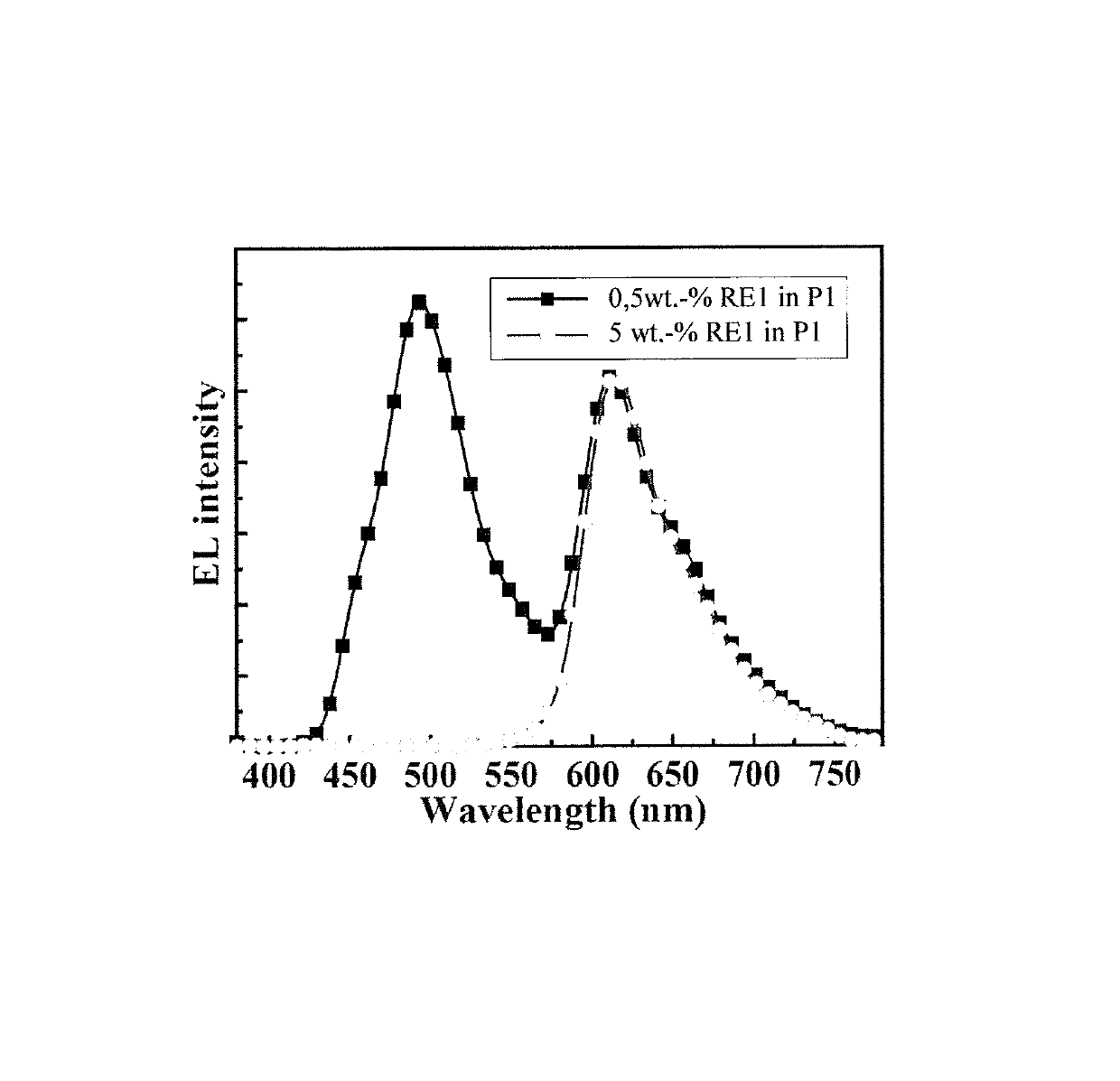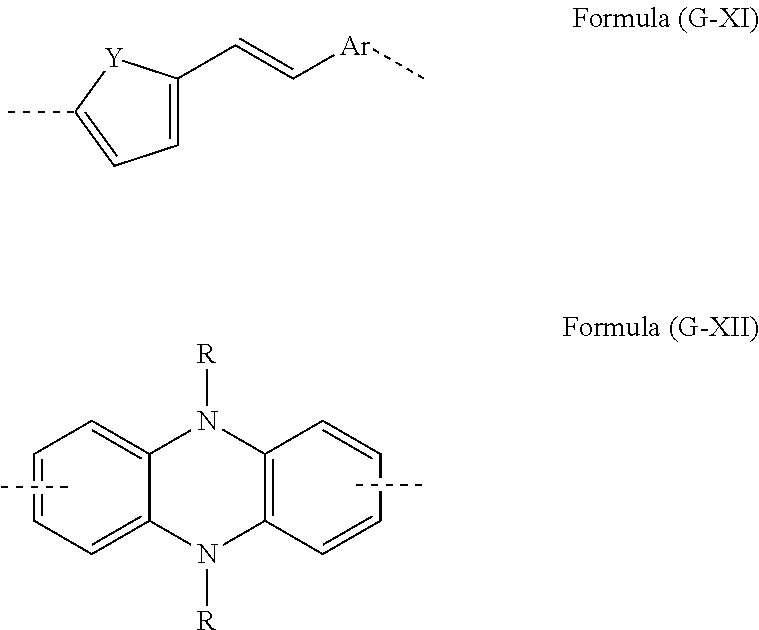White light emission
a technology of white light and light source, applied in the field of white light emission, can solve the problems of long time needed for forming p-n junction, difficulty in achieving desired color coordinates, and complex and costly preparation of oleds
- Summary
- Abstract
- Description
- Claims
- Application Information
AI Technical Summary
Benefits of technology
Problems solved by technology
Method used
Image
Examples
working examples
Example 1
[0151]Materials and Preparation of Conjugated Polymers
[0152]RE1 is a red light emitting phosphorescent small molecule emitter as disclosed in WO 2011 / 141120 A1
[0153]
[0154]Conjugated Polymer 1 (P1)
[0155]
[0156]P1 can be prepared according to WO 97 / 39045, WO 2003 / 020790, WO 2005 / 014688 using Suzuki coupling (WO 2003 / 048225).
[0157]Conjugated Polymer 2 (P2)
[0158]
wherein, m=0.5, n=0.35 and o=0.15. P2 can be prepared according to WO 98 / 27136, WO 99 / 24526, WO 98 / 25874.
[0159]Conjugated Polymer 3 (P3)
[0160]
[0161]P3 can be prepared according to WO 97 / 39045, WO 2003 / 020790, WO 2005 / 014688 using Suzuki coupling (WO 2003 / 048225).
[0162]The ion-transport material hydroxyl-endcapped trimethylolpropane ethoxylate (TMPE) and the salt LiCF3SO3 can be purchased from Aldrich (Steinheim, FRG). The salt is dried in a vacuum oven at T=473 K before use.
[0163]All materials are dissolved separately in anhydrous tetrahydrofuran at a concentration of 10 mg / ml. The active material solutions are prepared ...
example 2
[0164]Preparation of White Light Emitting OLEDs
[0165]For the OLED fabrication, poly(3,4-ethylenedioxythiophene)-poly(styrene sulfonate) (PEDOT:PSS, Clevios P VP AI 4083, Heraeus, FRG) is spin coated on top of carefully cleaned indium-tin-oxide (ITO) coated glass substrates (1.5×1.5 cm2, 20 ohms / square, Thin Film Devices, USA) at 4000 rpm for 60 s. The resulting 40 nm thick PEDOT:PSS film is dried at T=120° C. for 6 h. The active material is spin-coated from an active material solution at 2000 rpm for 60 s on top of the PEDOT:PSS layer. The resulting 120 nm thick active material is dried at T=50° C. for >5 h. The Ca cathodes (thickness: 20 nm), with an Al capping layer (thickness: 100 nm), are deposited on top of the active layer by thermal evaporation to complete the OLED structure.
[0166]Preparation of OLED1
[0167]According to the aforementioned method OLED1 having the following structure is prepared: ITO / PEDOT:PSS / P1:P2 (1.5 wt.-%):RE1 (0.8 wt.-%) / Ca / Al
[0168]Preparation of OLED2
[016...
example 3
[0170]Preparation of White Light Emitting OLECs
[0171]For the OLEC fabrication, poly(3,4-ethylenedioxythiophene)-poly(styrene sulfonate) (PEDOT:PSS, Clevios P VP AI 4083, Heraeus, FRG) is spin coated on top of carefully cleaned indium-tin-oxide (ITO) coated glass substrates (1.5×1.5 cm2, 20 ohms / square, Thin Film Devices, USA) at 4000 rpm for 60 s. The resulting 40 nm thick PEDOT:PSS film is dried at T=120° C. for 6 h. The active material is spin-coated from an active material solution at 2000 rpm for 60 s on top of the PEDOT:PSS layer. The resulting 120 nm thick active material is dried at T=50° C. for ≥5 h. Al cathodes (thickness: 100 nm) are deposited by thermal evaporation at p−4 Pa through a shadow mask to complete the OLEC structure.
[0172]Preparation of OLEC1
[0173]According to the aforementioned method OLEC1 having the following structure is prepared, wherein the mass ration of P1:P3:P2:RE1 is 100:1:1.5:1: ITO / PEDOT:PSS / P1:P3 (1.0 wt.-%):P2 (1.5 wt.-%):RE1 (1.0 wt.-%):Electroly...
PUM
| Property | Measurement | Unit |
|---|---|---|
| Nanoscale particle size | aaaaa | aaaaa |
| Nanoscale particle size | aaaaa | aaaaa |
| Nanoscale particle size | aaaaa | aaaaa |
Abstract
Description
Claims
Application Information
 Login to View More
Login to View More - R&D
- Intellectual Property
- Life Sciences
- Materials
- Tech Scout
- Unparalleled Data Quality
- Higher Quality Content
- 60% Fewer Hallucinations
Browse by: Latest US Patents, China's latest patents, Technical Efficacy Thesaurus, Application Domain, Technology Topic, Popular Technical Reports.
© 2025 PatSnap. All rights reserved.Legal|Privacy policy|Modern Slavery Act Transparency Statement|Sitemap|About US| Contact US: help@patsnap.com



